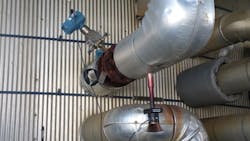Ashland’s plant in Lima, Ohio, converts low-value hydrocarbons into high-value organic chemical compounds via several processes. Other Ashland facilities use Lima’s exceptionally pure end products to make numerous useful solvents and additives. Unforeseen interruptions to this supply chain put millions of dollars of product at risk. So, insights into the condition of key process equipment can play an essential role in effective planning of inventories and production as well as for optimal scheduling of preventative maintenance to maximize productivity while eliminating unnecessary and unplanned downtime.
The hydrocarbon conversion process is challenging and requires extensive technical expertise and sophisticated equipment. One important component is a fluidized bed reactor that handles a highly exothermic reaction. It relies on cooling provided by superheating saturated steam. Fouling in the reactor’s steam coils can jeopardize the efficiency of the heat exchange. Even worse, fouling can cause leaks of superheated steam into the reactor that eventually damage the catalyst. Better monitoring of steam flow would enable determining the condition of the critical reactor coils and, thus, when appropriate scheduled maintenance was necessary. This, in turn, would allow the plant to operate the reactor with confidence.
Figure 1. Teaming of wireless transmitter with energy harvester provided an ideal solution for gathering data.
Providing that confidence would require capturing information about the condition of the superheated steam coils, initially with no process connections or flanges. The instrumentation would need to accommodate pipe surface temperatures in excess of 500°F in an area reachable only by scaffolding. This initially led to the testing of acoustic and temperature transmitters.
It was thought that gradual fouling of the steam pipes would cause changes in the acoustic signature of the steam flow. While measurement changes did occur, the acoustic signals didn’t show a strong correlation to variations in flow in the superheated steam coils.
The acoustic instruments did monitor surface temperature as well. When paired with the coil’s outlet (surface) temperature, evidence of fouling could be surmised over time but the meaning of real-time measurements wasn’t always clear. Because the differential temperature methods correctly identified fouled coils, the plant elected to install flanges to allow individual passes to be chemically cleaned.
[callToAction ]
The addition of flanges created the option for direct flow measurement — at a time the Rosemount unit of Emerson was looking for a beta tester for an experimental design that allowed top mounting of a differential pressure (DP) flow transmitter to a type-405C stainless-steel conditioning orifice plate in steam service. The Rosemount 3051 DP transmitter design avoided the need for heat-traced impulse lines. The wireless transmitter enabled getting flow measurements with minimal effort and installation cost.
The desired frequency of data readings from the flow meter raised an issue, though. A 4-sec update rate would require frequent battery maintenance in the extremely hot, hard-to-access location. With pipe temperatures greater than 500°F, the air temperatures around the transmitters easily could exceed 140°F. Given the high temperatures, the risk of burns and heat stroke are ever present. Even the toughest instrument technician was challenged during the initial equipment installations.
Looking for a way to tackle the battery replacement issue, the plant decided to explore the use of Power Puck thermoelectric energy harvesters. These small devices feature protruding heat-sink bristles and convert the heat flow from temperature differences directly into electricity. With heat sources ranging from “warm to the touch” to hot steam pipes, Power Pucks generate enough electricity to fully power the most-popular wireless transmitters for many years, eliminating the need for battery replacements. As long as a temperature difference is present, the thermoelectric energy harvester powers the transmitters; the battery is preserved for operation during turndowns and other occasions when a loss of process heat occurs. The devices are intrinsically safe and easy to install.
The plant installed a demonstration unit in November 2014that harvests heat from the steam lines. That Power Puck was a success. It has prevented equipment failures and also improved worker safety by eliminating the need to service batteries in high temperature locations only accessible with scaffolding.
Plant staff feel teaming the Power Puck with the Rosemount 3051 transmitter (Figure 1) has been very beneficial. They are impressed with the resiliency and ruggedness of the wirelessHART 3051 and the Power Puck in this harsh service — one that provides accurate steam flow measurements while extending the period for battery changes by many years. Now, the transmitters and Power Pucks can be ordered together directly from Emerson.
For Ashland, the project met the original goals, which included a greatly improved understanding of the condition of the reactor superheated steam coils. With this information, the plant can reduce the risk of unplanned outages while improving the effectiveness of scheduled turnarounds. Most importantly, the measurements enhance the reliability and confidence of the supply chain for the product made in the reactor and, thus, for end products that depend upon it.
JOHN REZABEK is aprocess control specialist at Ashland’s BDO manufacturing facility in Lima, Ohio. ANDY ZAREMBA is vice president of strategic partnerships for Perpetua Power Source Technologies,Corvallis, Ore. Email them at [email protected] and [email protected].

